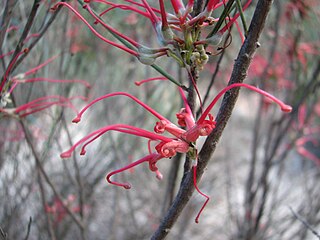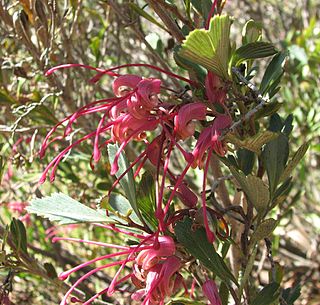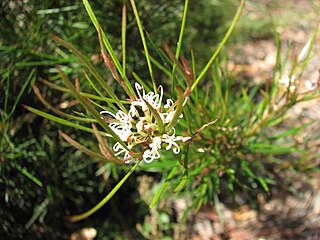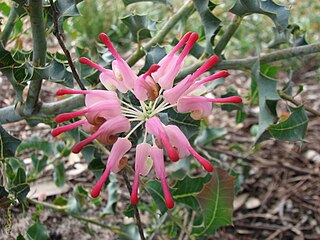
Grevillea obtusifolia, the obtuse-leaved grevillea, is a shrub which is endemic to the south-west of Western Australia. It grows up to between 0.5 and 1.5 metres in height and up to 5 metres in width. It produces pink to red flowers between August and November in its native range.

Grevillea pilosa is a low growing shrub which is endemic to the south-west of Western Australia. It grows to between 0.4 and 1 metre in height and produce red or pink flowers between June and December in its native range.

Grevillea rhyolitica, also known as Deua grevillea, is a shrub which is endemic to south-eastern New South Wales in Australia. It grows to between 0.5 and 2 metres in height.

Grevillea ripicola, commonly known as Collie grevillea, is a shrub which is endemic to the south west region of Western Australia. It grows to between 0.6 and 2 metres in height and up to 4 metres in width. The species was first formally described by botanist Alex George in Nuytsia in 1974 based on plant material collected at Collie. It is classified as Priority Four Flora (Rare) under the Wildlife Conservation Act in Western Australia.

Grevillea pimeleoides is a shrub which is endemic to the south west region of Western Australia.

Grevillea pinaster is a shrub in the family Proteaceae. It is endemic to south-western Western Australia.

Grevillea sarissa, the wheel grevillea, is a shrub which is native to South Australia and Western Australia.

Grevillea pteridifolia is a species of Grevillea native to Australia. Common names include silky grevillea, Darwin silky oak, ferny-leaved silky oak, fern-leaved grevillea, golden grevillea, golden tree and golden parrot tree. It occurs in Western Australia, Northern Territory, and Queensland.

Grevillea pectinata, commonly known as comb-leaf grevillea, is a shrub in the family Proteaceae. It is endemic to the south-west of Western Australia.

Grevillea diversifolia, the variable-leaved grevillea, is a species of flowering plant in the family Proteaceae and is endemic to the south-west of Western Australia. It is an erect to prostrate shrub with simple or divided leaves and groups white to cream-coloured flowers with a dull red style.

Grevillea neurophylla, commonly known as granite grevillea, is a shrub species in the family Proteaceae. It is native to the states of New South Wales and Victoria in Australia. The species was first formally described by French botanist Michel Gandoger in Bulletin de la Société Botanique de France in 1919. There are two subspecies:
Grevillea parviflora is a shrub species in the family Proteaceae. It is native to the state of New South Wales in Australia. There are two subspecies:

Grevillea dryandroides, commonly known as phalanx grevillea, is a species of flowering plant in the family Proteaceae and is endemic to the south-west of Western Australia. A diffuse, clumping shrub, it often forms suckers and has divided leaves with up to 35 pairs of leaflets, and groups of red to pinkish flowers on an unusually long, trailing peduncle.

Grevillea leucoclada is a species of flowering plant in the family Proteaceae and is endemic to a small area in the west of Western Australia. It is a shrub with divided leaves, the lobes further divided, the end lobes linear or tapered, and cone-shaped clusters of white to cream-coloured flowers.

Grevillea insignis, commonly known as wax grevillea, is a species of flowering plant in the family Proteaceae and is endemic to the south-west of Western Australia. It is an erect, bushy shrub with more or less oblong leaves with seven to seventeen sharply-pointed, triangular teeth, and more or less spherical or cylindrical clusters of cream-coloured flowers ageing to pink.

Grevillea ramosissima, commonly known as fan grevillea, is a shrub species of the family Proteaceae. It is native to south-eastern Australia.

Grevillea stenobotrya is a shrub or small tree in the family Proteaceae that is endemic to arid regions of Australia. Common names include rattle-pod grevillea, sandhill grevillea, sandhill oak and sandhill spider flower.
Grevillea nematophylla, commonly known as water bush or silver-leaved water bush, is a species of flowering plant in the family Proteaceae and is endemic to Australia. It is shrub or small tree with simple or pinnatisect leaves, the leaves or lobes linear, and branched, cylindrical clusters of cream-coloured flowers.

Grevillea brachystylis, also known as short-styled grevillea, is a species of flowering plant in the family Proteaceae and is endemic to the south-west of Western Australia. It is a low, spreading to erect shrub with linear to narrow egg-shaped leaves with the narrow end towards the base, and wheel-like clusters of hairy red flowers.

Grevillea coccinea is a species of flowering plant in the family Proteaceae and is endemic to the south of Western Australia. It is a low-lying or sprawling shrub with narrowly wedge-shaped to linear leaves and white, cream-coloured, and red or yellow flowers.


















